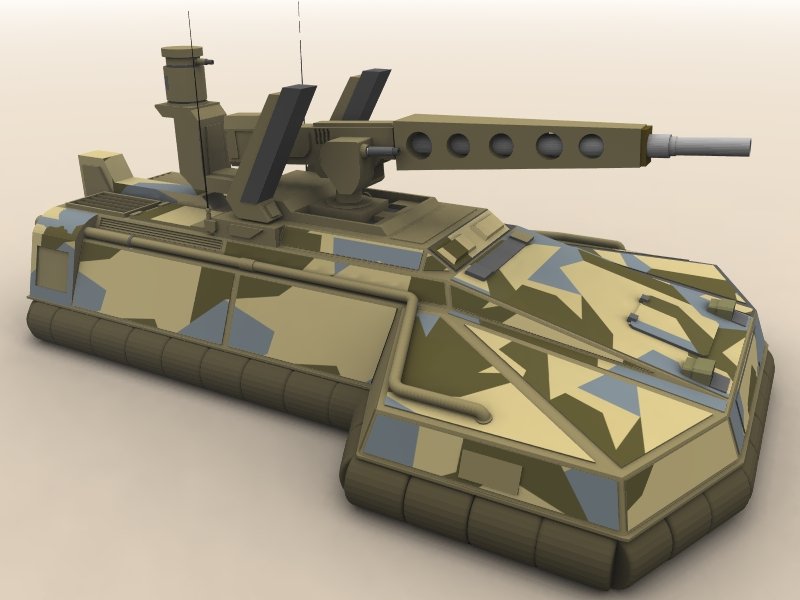
Luftkissenpanzer-IX
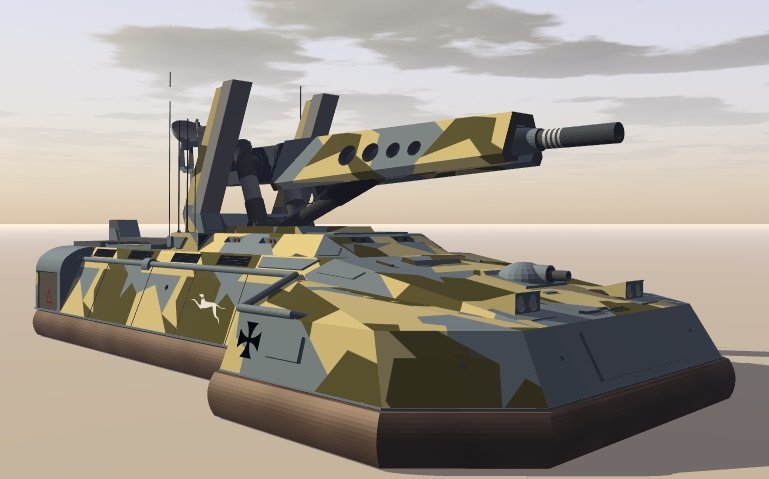
|
The Lufkissenpanzer-IX,
known as the LkPz-IX or Luki
9, is a modern hovertank which is the main HT
equipping the German Army. It is also in service with Azania
and several other nations. The LzPz-IX has seen heavy
action against the French and Kafers alike and is
regarded as one of the leading designs currently in service. In service since
the early 2290s the LzPz-IX has been the recipient of
several upgrades and redesigns. Narrative
Maréchal de Logis Delmas
swore violently as Lieutenant Abdelhamid’s AC-8 exploded suddenly off to his
left flank. The 2e Chasseurs d’Afrique had only been
inside Bavaria for less than half an hour and already they had lost over ten AFVs. The advance from the Rhine to the E35 road just short
of Freiburg im Breisgau should have been an easy drive but it wasn’t
turning out that why. The Chas d’Af had not been
greeted by cheering crowds of freshly liberated Bavarians as they’d expected,
but by empty villages and shoulder launched ATGWs.
Now they were in a shooting match with some low slung German tank hunters that
were hitting them with missiles from the flank. Delmas swung the AC-8 around and brought the
big 80mm MDC to bear on the firing point and the gunner rip with a barrage of
rounds. The rest of the troop fell in alongside him and added their fire, but
the Germans were no longer there. Plums of dirt showed where they raced back
from the advancing French to take up positions elsewhere in the rich terrain of
Baden-Wurttemburg with its rolling hills, small
villages and woods so ideal for ambush. His tracking software picked up a speeding hover
platform and tried to identify it. He got an 80% match on a tank destroyer but
he knew the profile was wrong. The damn thing had a massive gun mounted on the
top of it which slewed rapidly towards him. A part of his brain registered a
German flag at the same time as a Bavarian emblem that head fought alongside
only a few years before. ‘Break right! Break right!’ His driver complied
instantly as the German began pumping rounds out but his new wing man was a
moment too late. The AC-8 shuddered and sparked as the armour piercing rounds
hit home, the plenum emptied and the AC-8 bogged down scraping into the dark
soil, slewing to a halt. Delmas and the remaining
flanking AC-8 took cover behind a picturesque farmhouse as the striken AFV began to brew up, praying quietly for Allah to
be willing to let the crew survive as flames began to lick out of blown
hatches. Delmas stopped praying and started swearing again.
This wasn’t like the steppes of Central Asia and he needed to come up with a
new plan to take on these Germans. Extract from 'Southern Front: The
Drive to Stuttgart’ -
Col. Forbes L.
Harrison III, USA ret., Virginia Military Press, 2295 Variants
|
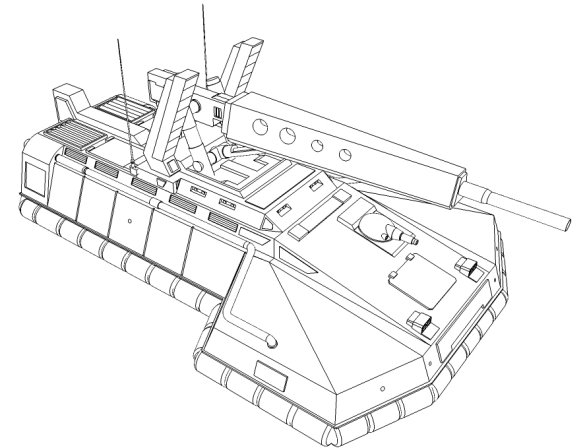
|
The LkPz-IX was
developed as a result of Bavarian and Westphalian
experience in the Central Asian War and the realisation of the failings of the LkPz-VIII in high intensity conflict. During the CAW it
quickly became obvious that the LkPz-VIII was
manifestly less capable than either the hard hitting and robust AC-8 or the
highly mobile Russian HT-82. Even the modernised LkPz-VIII
Ausf C with its upgraded gunnery systems and additional
armour was unable to overmatch its Manchurian opponents. The LkPz-IX was derived from work done by the Westphalian conglomerate Rheinfabrik on the mobile tank hunter the LkPzJg-XII which saw action with the Bavarian contingent in the middle years of the war. Although only armed with missiles the low slung and fast moving LkPzJg-XII had great success against Manchurian AFVs. Indeed it had a notably larger kill ratio than the Luki-8, although tactical handling was partly responsible for this. The Bavarian military staffed a requirement for a better armed LkPzJg-XII up through their system which brought about the involvement of Jaschonek Fabrikant. The new design,
bearing the unlikely name of Project Tannhäuser, combined
the basic chassis of the LkJgPz-II with JF’s latest
70mm MDC and a remotely operated turret. The first prototypes were not a
success however, being underpowered and suffering from poor systems
integration. This prompted a redesign of the chassis to incorporate the new Maybach 2MW MHD engine replacing the earlier 1MW version.
The end of the Central Asian War seemingly
brought Project Tannhäuser to
a halt, due in part to the large numbers of LkPz-VIIIs
of various models still being in service. In fact the project continued onwards
under a significant veil of secrecy and disguised as an improvement of the LkPzJg-XII In common with the emerging trend towards pan-German enterprises several other German Sates were brought in on the development of this new AFV. Hannover and Brandenberg signed up for the project alongside Westphalia and Bavaria. Hannover in particular was responsible for driving forward much of the project with a injection of new funding. A multinational testing and trials unit, Panzergruppe Lehr, was formed which conducted trials at Bavarian training areas in Garten with both LkPzJg-XIIs, late model LkPz-VIIIs and Project Tannhäuser prototypes. These were undertaken under the guise of passing on CAW experience to other German State forces. The first LkPz-IX models, the Ausf A, were delivered in 2291, initially to the Bavarian Army but with succeeding models to other German State forces. The next year with the Reunification of Germany Panzergruppe Lehr was initially converted to Brigade and then Divisional size and was fully equipped with LkPz-IX Ausf A. At the outbreak of the War of German Reunification no fewer than two full divisions and some minor units were equipped with these modern vehicles. The Ausf A was notable for its step change in capability even over the modernised LkPz-VIII Ausf E. Powerful, low slung, stealthy, heavily armoured, with advanced vectronics and modern weapons the new AFV was a match for almost any other hovertank then in service. Designed as a pure AFV killer it had a limited multi-role capability when compared with its French equivalents however. The Ausf A had a three man crew mounted in the hull of the vehicle, with the driver stationed forward right in the hull and the gunner and commander to the rear under the remote turret. The weapon suite included the newly developed 70mm MDC, two Luchs anti-vehicle missile launchers with 10 reloads and a single hull mounted 5.5mm machine gun. The Luchs had been battle proven in the last years of the CAW and were well regarded tank killers. The MDC was a CAW development originally designed for the up gunned Luki-VIII Ausf E, this was a sound weapon with a rapid rate of fire although it suffered in comparison with the modern French 65mm and some commentators questioned its capability to penetrate the frontal armour coming into service in other modern HTs. The vehicle also mounted close in Anti-Personnel System from a bank of 18 single shot grenade launchers mounted in the turret. The LkPz-IX also lacked a hard kill close protection system, relying instead on its speed and impressive EW suite. The continuing problems integrating the weapon systems had also not being completely surmounted, resulting in a lack of accuracy at medium and long ranges for the MDC when firing on automatic. This problem could be overcome by using the manual controls for engagements with the MDC, although this would limit the rate of fire somewhat. Many of these difficulties were attributed to the rapid introduction into service of the LkPz-IX The LkPz-IX Ausf A famously first saw action against the French during the War of German Reunification where in spite of being outnumbered by LkPz-VIII and other HT types it became the iconic image of German forces in the war. The LkPz-IX proved a match for the veteran French AC-8s and could outmanoeuvre the underpowered AC-10s but met a more equal enemy in the rare AC-12s it came across. The sheer capability of the LkPz-IX came as a real shock to the French who often mistook it for the LkPzJg-XII, which often led to serious casualties. The Luki-9 firmly cemented its reputation as one of the leading hovertanks around, earning accelerated production and a number of export orders. Already new models were under development and would soon being to replace the Ausf As in the core, however the Ausf A were soon in service in the colonies. Just under 30 Ausf As would see action on Aurore in the hands of French and Tanstaaflian crews as well as German technical advisors. Later 8 LkPzGr Division would take its Ausf As to war against the Kafers on every continent of Beta Canum IV. Although largely superseded by more modern models by 2300 the Ausf A is still an important part of the German arsenal and can be found in the ranks of several other nations. Type: German
Hovertank |
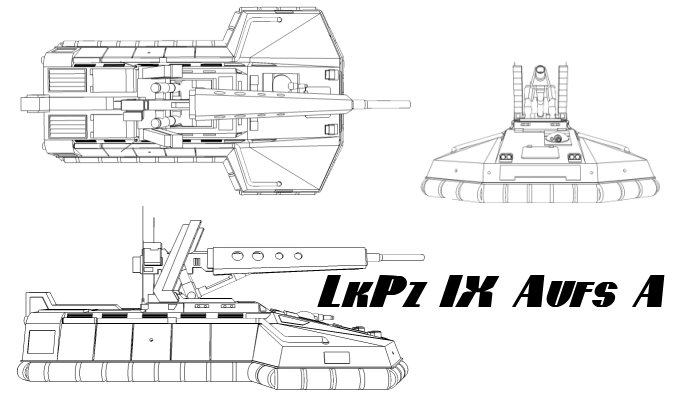
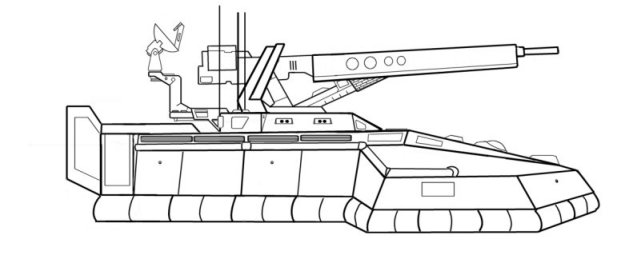
|
BfLkPz-IX
Ausf A
The ‘Befehls’, or command, variant of the Ausf
A was introduced alongside the main Ausf A design on
issue to company and battalion command staff. The main difference is in the
enhanced communications suite and the high capacity satellite uplink mounted to
the rear of the main gun. There was also a command version of the Ausf C model, however later models had enhanced
communications across the entire fleet.
|
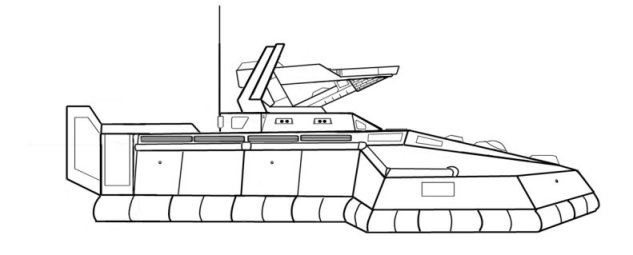
|
Aéro-Char
(Allemand) 10 Tonne AC(A)-10 is
the French designation for the LkPz-IX Ausf A in service with the French Army on Aurore after having been gifted by the German government.
There are only eight surviving vehicles still in service with the 1e Régiment de Cavalerie d'Aurore, a veteran French reconnaissance unit. The AC(A)-10s have been modified with the removal of the German
70mm MDCs (subsequently gifted to Tanstaafl)
and its replacement with the Darlan C-16 65mm MDC and
a coaxial 25mm autocannon mounted in a cradle. Germany
officially refers to this modification as the LkPz-IX
Ausf A2F
|
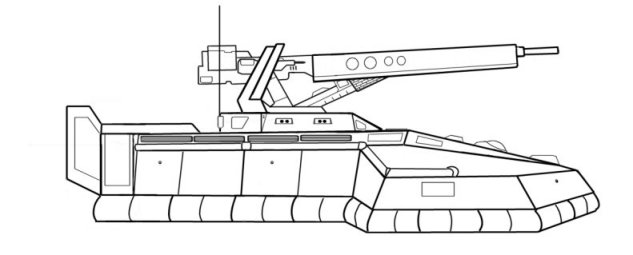
|
LkPz-IX
Ausf C
The Ausf C was designed to address some of the problems with
the Ausf As, mainly the systems integration. The vectronics were replaced with a much more effective system
and man-machine interface was greatly improved with the introduction of VHUD
displays for the crew. The Ausf C is capable of being
operated by only 2 crewmembers but most units continue to use 3 crew. The last
modification was the inclusion of a 7.5mm machine gun co-axially, addressing a
requirement for a greater capability to suppress enemy infantry. An attempt was
made to use the 30mm APS in a point defence system but this was abandoned.
The Ausf C was first introduced into service with the Bundesarmee on Earth in 2295 into units of I Korps. Although welcomed as a definite improvement in
comfort and operability there were some concerns raised that it was falling
behind the French who were developing the AC-12bis at the time. The Ausf C were dispatched to the
French Arm during the Kafer War, both equipping reinforcing units and as
replacements for already deployed units. Armament:
adds 1x
7.5mm machine gun (3000 rounds, coaxial with 70mm MDC).
Ngonyama Hover Tank
The Ngonyama (Zulu: Lion) is the LkPz-IX
in service with the Azanian Defence Force. First
procured in 2296 the Ngonyama most resembles the Ausf C and is produced under licence in Azania.
The differences are in the deletion of the hull mounted 5.5mm and the addition
of Azanian produced communications systems and the Sjambok close protection system. The Ngonyama
also boasts additional fuel tanks for extended range.
The Ngonyama has been heavily deployed in the northern Areas of
Operation in Angola and elsewhere as well as on Kimanjano
against the Kafers with elements of the 1st and 3rd
Mechanized Divisions.
|
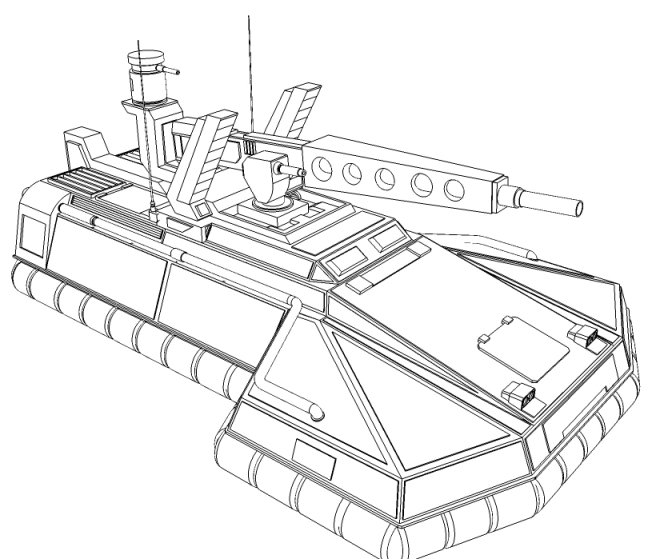
|
LkPz-IX
Ausf F
The Ausf F is the latest generation of the Luki-9, integrating
the lessons of the wars with the French and the Kafers.
The design features further enhanced vectronics,
communications, additional armour and a new 2.5MW MHD engine. In addition the
weapon suite has been overhauled with the latest generation of 70mm MDC with
increased armour and shielding, as well as a dedicated hard kill close
protection system based on the GW-120 AGL. The Ausf F
retains the coaxial 7.5mm and Luchs missiles but
removes the hull mounted 5.5mm and 30mm AP close in defence projectors.
The Ausf F formally moves to a two member crew arrangement,
although a jump seat is retained in the vehicle for transport of additional
personnel if required. This model also includes additional fuel tankage to enhance endurance. The Ausf
F is in service with a number of Terran based units
and at least two battalions operating in the French Arm including elements who
participated in the liberation of Dunkelheim. It is proving very popular and
believed to have closed the gap again on the AC-12bis. Type: German
Hovertank
The Luki-9 has proved a popular export vehicle
for Germany, especially to nations wishing to gain a highly capable modern AFV.
Flanders operates no fewer than three battalions of Ausf
As as part of its mechanised division. Russia
purchased a small number of LkPz-IXs which are
believed to have been for trials, although there are rumours that these are now
operating under the colours of the Central Asian Legion. Mozambique operates a mixed fleet of LkPz-IX Ausf As and Ngonyamas. Scandinavia has received several battalions of Ausf C models in the past several years. Spain and Croatia also have the LkPz-IX in service with their spearhead units. Tanstaafl has seven remaining Ausf As from its initial batch and is in negotiations to obtain an additional group of vehicles if possible. There are also several more nations who have varying numbers of Luki-9s in service.
|
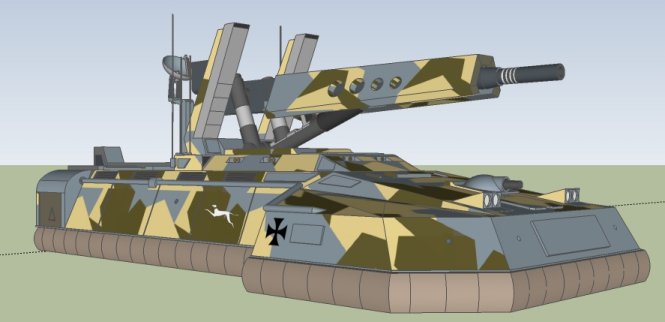
|
Rheinfabrik KwMK
45 70mm Mass Driver
Cannon The Rheinfabrik KwMK 45 was developed during
the Central Asian War to replace the KwMK 35s which
were then the main armament on the LkPz-VIIIs. The KwMK 45 was a
significantly better performing but larger MDC than its predecessor, although it
suffered in comparison to the contemporary and much more compact French 65mm.
It was however notably more robust and easier to maintain in the field. On the LkPz-VIX it was
mounted on the Ausf A and C models in the distinctive
remote turret above the hull. This cannon also saw
service on the LkPz-VIII Ausf
E. The main round used is an armour piercing but HEAT
rounds are also carried for use against different targets. An APSE round has
also been developed for greater effect against Kafer AFVs
combining a penetrator with a small enhanced blast
warhead in the base of the round. Type: 70mm Mass
Driver Cannon Fire Control:
+3 Rheinfabrik KwMK
47 70mm Mass Driver
Cannon The KwMK 47 is a
development of the earlier KwMK 47 developed to close
the gap on the Darlan C-16. The KwMK
47 features higher muzzle velocity and better field control enhancing its
delivery of kinetic APSFDS rounds. This MDC is mounted on the Ausf F and feature
enhanced shielding and armour for the gun with a more robust stabilisation
mechanism. Type: 70mm Mass
Driver Cannon Fire Control:
+4 MG-7 The MG-7 is the standard German Army conventional
5.5mm machine gun and is hull mounted in the Ausf A
and C models of the LkPz-IX. Many crews and
commentators have questioned the usefulness of the MG-7 with its limited
traverse ball turret and it has been omitted from later models and some export
versions. Type: 5.5mm machine gun Country: Germany Weight (empty): 4kg Length: 107cm Action: Single shot or Bursts Ammunition: 5.5mm x 40mm fixed cartridge ball Muzzle Velocity: 1200mps Magazine: 4000 round cassette ROF: 5 Rangefinder: +1 Aimed Fire Range: 900m Area Fire Burst: 20 rounds (AFV = 2) Area Fire Range: 700m DP Value: 0.6 Price: Lv900 MG-91 The MG-7 is the standard German Army conventional
7.5mm machine gun and is mounted coaxially with the main MDC in the Ausf C and later versions of the LkPz-IX
as well as on other newer German AFVs. This weapon is
relatively controversial as it doesn’t offer much greater performance than the
lighter MG-7. Type: 7.5mm machine gun Country: Germany Weight (empty): 7kg Length: 110cm Action: Single shot or Bursts Ammunition: 7.5mm x 35mm fixed cartridge ball Muzzle Velocity: 960mps Magazine: 3000 round cassette ROF: 5 Rangefinder: +3/+4 (depending on model)
Aimed Fire Range: 800m Area Fire Burst: 20 rounds (AFV = 2) Area Fire Range: 780m DP Value: 0.7 Price: Lv950 GW-50 Anti-Personnel System The GW-50 is a system of 18 single barrelled
grenade launchers mounted on the sides and front of the remote turret. They are
single shot and manually reloaded weapons with only limited accuracy designed
to be volley fired to allow a vehicle to escape from a close in ambush. Long
regarded as a marginal weapon system it has been omitted from the Ausf F models, although some LkPz-IX
crews have sworn by the systems’ ability to lay down a mixture of flechette and smoke grenades when in close quarters against
the Kafers.
Type: 18 barrelled 30mm fixed grenade launcher
system Country: Germany Weight (empty): n/a
Length: 30cm Action: Single shot or volleys. Manually reloaded. Ammunition: Any 30mm propelled grenade
Muzzle Velocity: 400mps Magazine: 32 grenades total in vehicle.
ROF: 1-18 – max 6 only in each arc Rangefinder: 0 Aimed Fire Range: 30m DP Value: dependent on grenade used. Price: Lv2000 GW-121 AGL and PD System Developed from the GW-120 AGL this system
combines an AGL and point defence system although on the LkPz-IX
it is primarily used as in the PD role. However one of the two hoppers can be
used for anti-personnel or obscuration rounds if required. The GW-121 combines
the AGL with an optical and MMW tracking system cued by the vehicle’s targeting
systems. It is included on the Ausf F model. Type: 30mm vehicle mounted automatic grenade
launcher and point defence system Country: Germany Action: Single shot or Bursts Ammunition: Any 30mm propelled grenade Muzzle Velocity: 400mps Magazine: 2 x 40 round hoppers ROF: 2 Rangefinder: +3/+4 (depending on model)
Aimed Fire Range: 500m DP Value: Dependent on grenade used Price: Lv 7000 Luchs Anti-Vehicle Missile
The Luchs is Germany’s
standard AVM battle proven in the CAW in Bavarian hands. While the missile and
its guidance systems have been progressively upgraded the system remains
essentially the same. While the missile can be outranged by its French
equivalent it is slightly more accurate that the Manta-1. The LkPz-IX has two rear mounted vertical Luchs
launchers each with five missiles in an automatic magazine. Type: Vehicle Mounted Anti-Vehicle Missile Nation: Germany Launcher Weight: 120kg Range: 7000m Guidance: Automatic Homing Value: 17 Attack Angle: selectable Damage: EP=40 Launcher Price: Lv4000 Missile Price: Lv5000 Sjambok Close Defence System The Sjambok is a fairly
standard MG-based point defence system, installed on a number of Azanian AFVs. The system mounts a
short-barrelled variant of the R62 binary HMG to ensure clearance between the rear
Sjambok positions and the turret. For passive defence an 18mm R65 automatic
launcher is mounted coaxially. In theory this could fire standard shotgun
shells, but it is exclusively intended as launcher for obscuration and decoy
cartridges. As the R65 does not have a dual-feed capability it is standard
practice in the Azanian Army Ngonyamas
to alternate decoy rounds and obscuration rounds. Sjambok is capable of both
anti-missile and anti-personnel roles, with both modes capable of fully
automated operation. IFF functionality is incorporated, but is not 100%
effective against ground targets. Active gunner control is preferred where
there are friendly troops on the ground and when this is operating two weapons
may be simultaneously slaved to the gunner’s targeting system. The Ngonyama
mounts a single Sjambok system to the rear of the remote turret. Type: Close Defense System Country:
Azania Weight: 175 kg (complete with 1000 rounds of 9mm
binary and 200 18mm cartridges) Armament: 1 * R62 Mod 2 9mm HMG
with 1000 rounds and + 2 Fire Control 1 * R65 18mm Launcher
with 200 rounds and +1 fire control ROF: 5 per installation Price: Lv 10,000 |
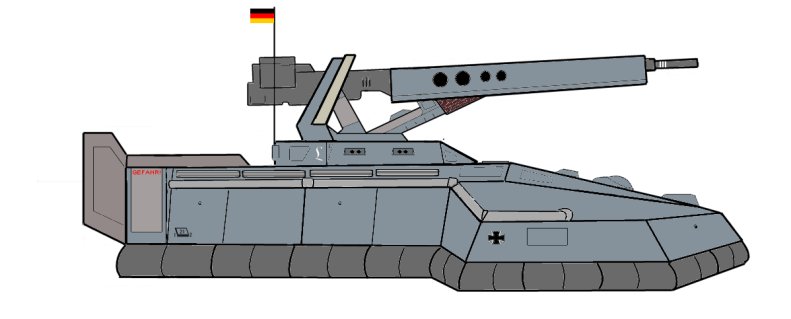
|
LkPz-IX Ausf A, 2 Kompanie,
Luftkissenpanzer Abteilung 21, 2 Luftkissenpanzer Brigade 'Bayerlein',
Luftkissenpanzer Division 'Lehr' Karlsruhe, Baden, Germany, Terra, 7th February
2293
This plate
shows an early model Ausf A in the hands of the Lehr
Division which was the first pan-German Division formed for the new Bundeswehr. The Lehr Division was formed by veteran
soldiers from across the various German State armies and was initially tasked
with trialling the prototype Luki-9. The plate shows one of the Division’s LkPz-IX just about to go into action in the Rhine Valley
against the French.
Key
recognition marks are the tactical symbol, the divisional symbol and the
hastily applied kill markings on the MDC barrel. The camouflage scheme is the
then standard single blue-grey colour. |
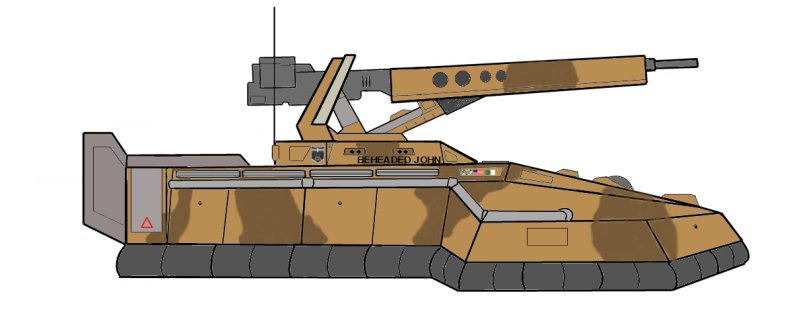
|
LkPz-IX
Ausf A, Autonomous Hovertank
Company, Tanstaafl Free Legion Thunder Valley, Tanstaafl,
Aurore, 2nd October 2300
This plate
shows one of the Luki-9s gifted to Tanstaafl by the
German government following training by a special advisory mission by German
forces from Beta Canum. The Autonomous Hovertank Company was formed from those TFL mercenaries
with AFV experience who were run through a truncated training process by the
Germans. This image is taken of a vehicle which participated in the famous
Thunder Valley mission by Tanstaafl forces which
destroyed a large Kafer force. The Luki-9 is painted in a two tone pattern
designed for operations in the east of the colony, it
is assumed there was no time to repaint before being committed to action.
Key
recognition marks are the TFL insignia, the name ‘Beheaded John’ derived from a
passage in Luke Chapter 9 in the Bible. In addition this Luki
carries American, Bavarian and Algerian flags denoting the nationality of its
crewmen. |
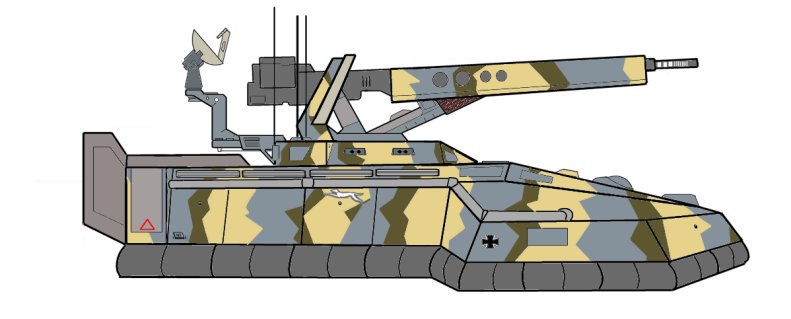
|
BfLkPz-IX Ausf C, 1 Kompanie, Luftkissenpanzer Abteilung 143, 14
Luftkissenpanzergrenadier Brigade, 4 Kolonial Luftkissenpanzergrenadier
Division Hexenkessel, Dunkelheim, 25th December 2302
This plate
shows the BfLkPz-9 Ausf C commanded by
Oberleutnant Wilhelm Sandrock, the
highest scoring German tank ace of the Kafer War. Sandrock had been part of the
mission to Aurore as part of the continent from 8 LkPzGren Div and would later serve with that division in
the defence of Beta Canum.
Promoted in the field and highly decorated Sandrock became something of a
legend in the Bundeswehr. This picture is taken
shortly before the loss of this vehicle during his 40th kill during the
Liberation of Dunkelheim. This plate shows Sandrock’s kill markers on the barrel as well as the tactical insignia of his unit. Prominent is the ‘greyhound’ emblem of 8 Division which was also carried by the 14th Brigade which had previously belonged to that Division. The colour scheme is a disruptive pattern specifically designed for operations within the Kamelinsekt habitats of Dunkelheim.
Rheinfabrik is by A Gubler. The
Sjambok point defence
system is by David Gillon. The original LkPz-IX is described in the Ground Vehicle Guide and some
of its weapons are taken from the 1st Edition Players Guide. The line drawings are by D Hebditch and are derived from the LkPz-IX drawings in the Ground Vehicle Guide and the drawing in the Aurore Sourcebook. They follow the general dimensions of the Aurore SB vehicle while taking details from the GVG drawing. I have used the canon from the Aurore SB as the basis of the KwMK 47. 3D pictures are by Ian Stead.
Copyright 2010, D Hebditch and Ian Stead. 13
Feb 10 |
